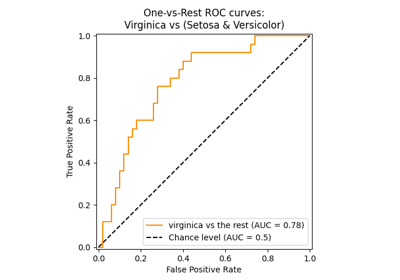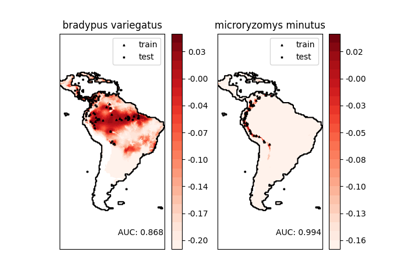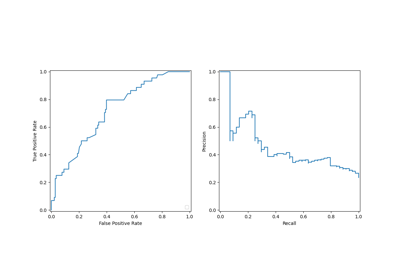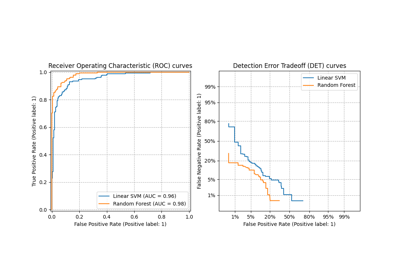sklearn.metrics.roc_curve#
- sklearn.metrics.roc_curve(y_true, y_score, *, pos_label=None, sample_weight=None, drop_intermediate=True)[source]#
Compute Receiver operating characteristic (ROC).
Note: this implementation is restricted to the binary classification task.
Read more in the User Guide.
- Parameters:
- y_truearray-like of shape (n_samples,)
True binary labels. If labels are not either {-1, 1} or {0, 1}, then pos_label should be explicitly given.
- y_scorearray-like of shape (n_samples,)
Target scores, can either be probability estimates of the positive class, confidence values, or non-thresholded measure of decisions (as returned by “decision_function” on some classifiers).
- pos_labelint, float, bool or str, default=None
The label of the positive class. When
pos_label=None, ify_trueis in {-1, 1} or {0, 1},pos_labelis set to 1, otherwise an error will be raised.- sample_weightarray-like of shape (n_samples,), default=None
Sample weights.
- drop_intermediatebool, default=True
Whether to drop some suboptimal thresholds which would not appear on a plotted ROC curve. This is useful in order to create lighter ROC curves.
New in version 0.17: parameter drop_intermediate.
- Returns:
- fprndarray of shape (>2,)
Increasing false positive rates such that element i is the false positive rate of predictions with score >=
thresholds[i].- tprndarray of shape (>2,)
Increasing true positive rates such that element
iis the true positive rate of predictions with score >=thresholds[i].- thresholdsndarray of shape (n_thresholds,)
Decreasing thresholds on the decision function used to compute fpr and tpr.
thresholds[0]represents no instances being predicted and is arbitrarily set tonp.inf.
See also
RocCurveDisplay.from_estimatorPlot Receiver Operating Characteristic (ROC) curve given an estimator and some data.
RocCurveDisplay.from_predictionsPlot Receiver Operating Characteristic (ROC) curve given the true and predicted values.
det_curveCompute error rates for different probability thresholds.
roc_auc_scoreCompute the area under the ROC curve.
Notes
Since the thresholds are sorted from low to high values, they are reversed upon returning them to ensure they correspond to both
fprandtpr, which are sorted in reversed order during their calculation.An arbitrary threshold is added for the case
tpr=0andfpr=0to ensure that the curve starts at(0, 0). This threshold corresponds to thenp.inf.References
[2]Fawcett T. An introduction to ROC analysis[J]. Pattern Recognition Letters, 2006, 27(8):861-874.
Examples
>>> import numpy as np >>> from sklearn import metrics >>> y = np.array([1, 1, 2, 2]) >>> scores = np.array([0.1, 0.4, 0.35, 0.8]) >>> fpr, tpr, thresholds = metrics.roc_curve(y, scores, pos_label=2) >>> fpr array([0. , 0. , 0.5, 0.5, 1. ]) >>> tpr array([0. , 0.5, 0.5, 1. , 1. ]) >>> thresholds array([ inf, 0.8 , 0.4 , 0.35, 0.1 ])
Examples using sklearn.metrics.roc_curve#

Multiclass Receiver Operating Characteristic (ROC)



